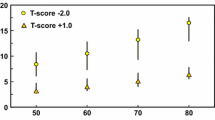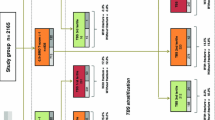Abstract
Summary
The study investigates the association of trabecular bone score (TBS) and fractures among minority populations. In NHANES 2005-2008, TBS was associated with history of fractures in Caucasian subjects but demonstrated somewhat weaker associations in African American and Mexican American women.
Introduction
Trabecular bone score (TBS), a textural analysis of the lumbar spine DXA image, predicts fractures well in Caucasian (CA) and Asian populations but is less well studied in African American (AA) and Mexican American (MA) subjects. It is not clear whether TBS is associated with or is predictive of fragility in these racial/ethnic groups.
Methods
We analyzed data from subjects from NHANES 2005-2008 over the age of 40 who had TBS: 1178 CA, 467 AA, and 397 MA women and 1200 CA, 502 AA, and 386 MA men. TBS was categorized into normal, ≥ 1.310, partially degraded < 1.310, and > 1.230, or degraded, ≤ 1.230. History of fracture was assessed by questionnaire.
Results
Among women, there was an increasing prevalence of fracture with worsening TBS category. However, when controlling for age, BMI, and low T-score, the association between TBS category and previous fracture was only significant in CA women (OR 1.49 per worsening category, 95% CI 1.20–1.85). In men, there was also an increase in the prevalence of fracture with worsening TBS category in all races/ethnicities. When controlling for age, BMI, and low T-score, the association between TBS category and previous fracture was only significant in CA men (OR 1.47 per worsening category, 95% CI 1.10–1.95), though analysis was somewhat limited by small fracture numbers.
Conclusions
The association of fracture and TBS varies by race/ethnicity and gender with weaker association observed in AA and MA women. More research is needed to define the proper use of TBS for predicting fractures in minority groups.


Similar content being viewed by others
References
Facts and Statistics | International Osteoporosis Foundation. https://www.iofbonehealth.org/facts-statistics. Accessed 28 Nov 2017
Pasco JA, Seeman E, Henry MJ, Merriman EN, Nicholson GC, Kotowicz MA (2006) The population burden of fractures originates in women with osteopenia, not osteoporosis. Osteoporos Int 17:1404–1409
Sanders KM, Nicholson GC, Watts JJ, Pasco JA, Henry MJ, Kotowicz MA, Seeman E (2006) Half the burden of fragility fractures in the community occur in women without osteoporosis. When is fracture prevention cost-effective? Bone 38:694–700
Silva BC, Leslie WD, Resch H, Lamy O, Lesnyak O, Binkley N, McCloskey EV, Kanis JA, Bilezikian JP (2014) Trabecular bone score: a noninvasive analytical method based upon the DXA image. J Bone Miner Res 29:518–530
Silva BC, Walker MD, Abraham A, Boutroy S, Zhang C, McMahon DJ, Liu G, Hans D, Bilezikian JP (2013) Trabecular bone score is associated with volumetric bone density and microarchitecture as assessed by central QCT and HRpQCT in Chinese American and white women. J Clin Densitom 16:554–561
McCloskey EV, Odén A, Harvey NC et al (2016) A meta-analysis of trabecular bone score in fracture risk prediction and its relationship to FRAX. J Bone Miner Res 31:940–948
2015 ISCD Official Positions-Adult-International Society for Clinical Densitometry (ISCD). http://www.iscd.org/official-positions/2015-iscd-official-positions-adult/. Accessed 2 Jul 2016
Kim JH, Choi HJ, Ku EJ, Kim KM, Kim SW, Cho NH, Shin CS (2015) Trabecular bone score as an indicator for skeletal deterioration in diabetes. J Clin Endocrinol Metab 100:475–482
Leslie WD, Aubry-Rozier B, Lamy O, Hans D (2013) TBS (trabecular bone score) and diabetes-related fracture risk. J Clin Endocrinol Metab 98:602–609
McCloskey EV, Odén A, Harvey NC et al (2015) Adjusting fracture probability by trabecular bone score. Calcif Tissue Int 96:500–509
Jain RK, Narang DK, Hans D, Vokes TJ (2017) Ethnic differences in trabecular bone score. J Clin Densitom 20:172–179
Looker AC, Isfahani NS, Fan B, Shepherd JA (2016) Trabecular bone scores and lumbar spine bone mineral density of US adults: comparison of relationships with demographic and body size variables. Osteoporos Int 27:2467–2475
Jain RK, Vokes TJ (2017) African Americans have lower TBS than whites among densitometry patients at a Chicago academic center. Osteoporos Int 28:917–923
Center for Disease Control and Prevention NHANES 2005-2006–Questionnaires, Datasets, and Related Documentation. https://wwwn.cdc.gov/nchs/nhanes/continuousnhanes/default.aspx?BeginYear=2005. Accessed 8 Jan 2018
Center for Disease Control and Prevention NHANES 2007–2008-Questionnaires, Datasets, and Related Documentation. https://wwwn.cdc.gov/nchs/nhanes/continuousnhanes/default.aspx?BeginYear=2007. Accessed 8 Jan 2018
Boutroy S, Hans D, Sornay-Rendu E, Vilayphiou N, Winzenrieth R, Chapurlat R (2013) Trabecular bone score improves fracture risk prediction in non-osteoporotic women: the OFELY study. Osteoporos Int 24:77–85
Briot K, Paternotte S, Kolta S, Eastell R, Reid DM, Felsenberg D, Glüer CC, Roux C (2013) Added value of trabecular bone score to bone mineral density for prediction of osteoporotic fractures in postmenopausal women: the OPUS study. Bone 57:232–236
Hans D, Goertzen AL, Krieg M-A, Leslie WD (2011) Bone microarchitecture assessed by TBS predicts osteoporotic fractures independent of bone density: the Manitoba study. J Bone Miner Res 26:2762–2769
Barrett-Connor E, Siris ES, Wehren LE, Miller PD, Abbott TA, Berger ML, Santora AC, Sherwood LM (2005) Osteoporosis and fracture risk in women of different ethnic groups. J Bone Miner Res 20:185–194
Looker AC (2013) Femur neck bone mineral density and fracture risk by age, sex, and race or Hispanic origin in older US adults from NHANES III. Arch Osteoporos 8:1–11
Cauley JA, Lui L-Y, Ensrud KE, Zmuda JM, Stone KL, Hochberg MC, Cummings SR (2005) Bone mineral density and the risk of incident nonspinal fractures in black and white women. Jama 293:2102–2108
Cauley JA, Wu L, Wampler NS, Barnhart JM, Allison M, Chen Z, Jackson R, Robbins J (2007) Clinical risk factors for fractures in multi-ethnic women: the women’s health initiative. J Bone Miner Res 22:1816–1826
Cauley JA, Palermo L, Vogt M, Ensrud KE, Ewing S, Hochberg M, Nevitt MC, Black DM (2008) Prevalent vertebral fractures in black women and white women. J Bone Miner Res 23:1458–1467
Vokes TJ, Gillen DL, Pham AT, Lovett JM (2007) Risk factors for prevalent vertebral fractures in black and white female densitometry patients. J Clin Densitom 10:1–9
Zhou B, Wang J, Stein EM, Zhang Z, Nishiyama KK, Zhang CA, Nickolas TL, Shane E, Guo XE (2014) Bone density, microarchitecture and stiffness in Caucasian and Caribbean Hispanic postmenopausal American women. Bone Res 2:14016
Bauer RL (1988) Ethnic differences in hip fracture: a reduced incidence in Mexican Americans. Am J Epidemiol 127:145–149
Bauer RL, Deyo RA (1987) Low risk of vertebral fracture in Mexican American women. Arch Intern Med 147:1437–1439
Kanis JA, Odén A, McCloskey EV et al (2012) A systematic review of hip fracture incidence and probability of fracture worldwide. Osteoporos Int 23:2239–2256
Schacter GI, Leslie WD, Majumdar SR, Morin SN, Lix LM, Hans D (2017) Clinical performance of an updated trabecular bone score (TBS) algorithm in men and women: the Manitoba BMD cohort. Osteoporos Int 28:3199–3203
Leslie WD, Aubry-Rozier B, Lix LM, Morin SN, Majumdar SR, Hans D (2014) Spine bone texture assessed by trabecular bone score (TBS) predicts osteoporotic fractures in men: the Manitoba bone density program. Bone 67:10–14
Pressley JC, Kendig TD, Frencher SK, Barlow B, Quitel L, Waqar F (2011) The epidemiology of bone fracture across the age span in blacks and whites. J Trauma 71:S541–S548
Singer BR, McLauchlan GJ, Robinson CM, Christie J (1998) Epidemiology of fractures in 15 000 adults. J Bone Joint Surg Br 80:243–248
Rahman M, Temple JR, Breitkopf CR, Berenson AB (2009) Racial differences in body fat distribution among reproductive-aged women. Metabolism 58:1329–1337
Mazzetti G, Berger C, Leslie WD, Hans D, Langsetmo L, Hanley DA, Kovacs CS, Prior JC, Kaiser SM, Davison KS, Josse R, Papaioannou A, Adachi JR, Goltzman D, Morin SN, CaMos Research Group (2017) Densitometer-specific differences in the correlation between body mass index and lumbar spine trabecular bone score. J Clin Densitom 20:233–238
Klotzbuecher CM, Ross PD, Landsman PB, Abbott TA 3rd, Berger M (2000) Patients with prior fractures have an increased risk of future fractures: a summary of the literature and statistical synthesis. J Bone Miner Res 15:721–739
Ross PD, Genant HK, Davis JW, Miller PD, Wasnich RD (1993) Predicting vertebral fracture incidence from prevalent fractures and bone density among non-black, osteoporotic women. Osteoporos Int 3:120–126
Ross PD, Davis JW, Epstein RS, Wasnich RD (1991) Pre-existing fractures and bone mass predict vertebral fracture incidence in women. Ann Intern Med 114:919–923
Graham JE, Chang P-FJ, Bergés I-M et al (2008) Race/ethnicity and outcomes following inpatient rehabilitation for hip fracture. J Gerontol A Biol Sci Med Sci 63:860–866
Sterling RS (2011) Gender and race/ethnicity differences in hip fracture incidence, morbidity, mortality, and function. Clin Orthop Relat Res 469:1913–1918
Author information
Authors and Affiliations
Corresponding author
Ethics declarations
Conflicts of interest
None.
Rights and permissions
About this article
Cite this article
Jain, R.K., Vokes, T. Association of trabecular bone score (TBS) and prior fracture differs among minorities in NHANES 2005-2008. Osteoporos Int 29, 2093–2099 (2018). https://doi.org/10.1007/s00198-018-4584-8
Received:
Accepted:
Published:
Issue Date:
DOI: https://doi.org/10.1007/s00198-018-4584-8




